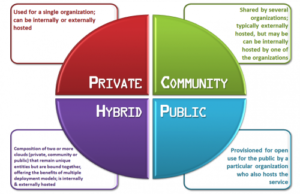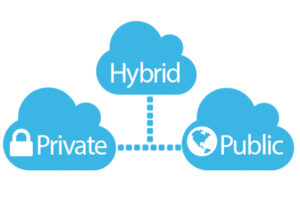Types of Cloud Computing
Although the term “cloud” often offers cloud computing some unintelligible impression, in realism, not all that is dissimilar from traditional computer construction. Cloud computing still relies on the physical server hardware that styles up the backbone of any PC network. The difference is that cloud design makes the dispensation power and storage capacity of that hardware available online. This allows cloud providers to use distributed servers around the world to build an integrated, powerful computer network that can be accessed from any internet connection. This has proven to be very important as organizations switch to remote work areas in response to COVID-19.
Cloud computing has become a mutual word for the past decade, but the service sometimes creates confusion. With all the new cloud options and the phrase “as a service” seems to be incorporated into everything you can think of, it is helpful to go back and look at the differences between the main types of cloud deployments and the different types of computer services.
Types of Cloud Computing
Cloud deployment describes how the cloud platform is created, how it is managed, and who has access to it. All applications of cloud computing work on the same principle by making the computing power of servers into separate, software-driven systems that provide processing and storage capabilities.
Public Cloud
Other examples of public cloud include those provided by Amazon, Microsoft, or Google. These companies provide services and infrastructure, shared by all customers. Public clouds often have a large amount of available space, which translates to simplicity. The public cloud often recommends for software development and collaboration projects. Companies can design their own portable applications so that a project that tests in a public cloud transfers to an independent production cloud. Most cloud providers install their computer resources as part of the service. Examples of public clouds range from access to fully customized infrastructure that offers more than just green storage and storage (Infrastructure as a Service. Or IaaS) to special software applications that are easy to use and use (Software as a service, or SaaS).
Private Cloud
Private clouds usually reside after a firewall and use by a single company. A fully structured cloud can be a popular solution for businesses with very stringent legal requirements, although independent cloud startups using a colocation provider are gaining popularity. Authorized users can access, use, and store data in a private cloud from anywhere, just as they can with a public cloud. The difference is that no one else can access or use those computer resources. Private cloud solutions offer security and control, but these benefits come at a cost. The company that owns the cloud is responsible for both software and infrastructure, making this a less expensive model than public cloud computing.
Additional controls provided by the private cloud create it easy to limit access to important assets and ensure that the company will be able to move its data and applications where it wants, whenever they want. Moreover, since the private cloud can be controlled by an external vendor, there is no risk of sudden changes affecting the entire company’s infrastructure? The private cloud solution will no longer affect during the downtime of the public cloud provider program. But private clouds also lack the flexibility of public clouds. They can only be expanded by adding a portable computer and storage capacity, making it difficult to measure performance quickly when a business is emerging.
Hybrid Cloud
Hybrid clouds include public and private clouds. They design to allow both platforms to interact freely, with data and applications moving smoothly from one to the other.
The main advantage of the hybrid cloud model is its capability to offer awesome computer power to public cloud security and private cloud control. Data safely store behind firewalls and encryption protocols for the private cloud. And then securely moved to a public cloud area where needed. This is especially helpful in the era of big data statistics. Where industries such as healthcare must adhere to strict data privacy laws while also using the advanced technology provided by artificial intelligence (AI) to gain practical insight from a wide range of informal data.
There are two widely uses types of hybrid cloud construction. Cloud bursting uses the private cloud as its core cloud, data storage, and housing applications in a secure environment. When the service wants to increase, however, private cloud infrastructure may not be able to keep up. That’s where the public cloud comes in. The cloud computing model uses public cloud computing services to add a private cloud. Allowing the company to handle additional traffic without having to purchase new servers or other infrastructure.
Community Cloud
Although not as commonly used as the other three models. Public clouds are a collaborative, multi-employment platform used by several different organizations to share similar programs. Users usually work within the same industry or field and share common concerns about security, agreement, and performance.
In fact, the public cloud is a free cloud that acts as a public cloud. The platform itself privately own, either in a data center or in a building. Authorized users are then categorized between those environments. These resources often used by government agencies, health organizations, financial services firms, and other expert areas.
Here at TechTronicx Technologies, I have explained the different types of cloud computing. If you want more information about the current technology trends visit our website.


0 Comments